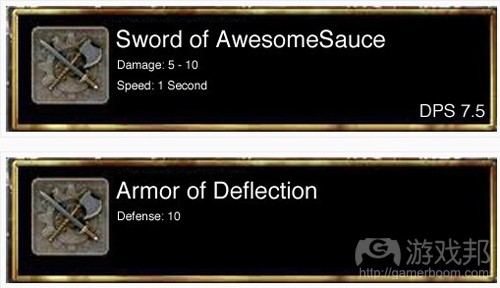分析《怪诞行为学》对游戏经济系统设计的启发
作者:Mike Birkhead
《怪诞行为学》是本有关行为经济学的书籍。这是经济学研究中相对较新的领域,该书刚开始便提出人类并非像传统经济学认为的那样理性,事实上我们的怪诞和非理性行为已经达到了可以预测的程度。该书作者Dan Ariely解析了怪诞行为多个要点的细节,然后用该领域内的实验加以论证。这些实验读起来既有趣,又带有启发性。
在本书大量的话题中,给我造成最大冲击的莫过于作者对常见游戏设计问题的清晰洞察和解读。相对论、零的力量、社会与市场间的互换,以及伦理和作弊的力量等话题都向我展示出思考常见问题的新方法,而且我确信应该还可以从中挖掘出更多的内容。看到第2章,我就认为这本书值得每个游戏设计师阅读。
所有事物都是相对的
当人们在两个选项间做决定时,最终目标是找到那个能带来最大“效用”的选择。简单地说,人们努力找出那个能带来最大快乐的选择。根据经济学理论,理性的人类会审视他们的选项,根据指标衡量每个选项,然后计算出可能获得的效用。当行为经济学的认为,事情并非如此简单。人类并非以绝对价值来比较事物,而是相对价值。
“人类几乎不会以绝对价值来做出选择。我们没有内在价值标尺来告诉我们事物的价值。然而,我们会专注于一种事物与另一种事物相比的相对优势,据此来估算价值。”——Dan Ariely
这句话是什么意思呢?如果我想以5美元的价格将Hoojaz出售给你,你可能并不确定这是否是个划算的交易。Hoojaz真得值5美元吗?我不知道。现在,假如我仍以5美元的价格出售Hoojaz和Whatsit两件商品,情况又会如何呢?你或许会认为我是个愚蠢的商人,但事实上我是个天才,因为我给你提供了相对参照物。之前,你或许不确定Hoojaz是否真得值5美元,但现在你情不自禁地开始认为花同样的金钱购买Hoojaz和Whatsit两件商品是个很划算的交易。
这些内容非常有趣,尤其是对那些商人来说。但是,相对论还有更多的内涵。人类专注于以相对的方法来比较事物,但是我们也趋向于将注意力集中在以最简单的可行方法来比较事物上,同时尽全力避免困难的比较。假设我让你从以下这两样东西中做出选择:
选项A是把秒伤7.5的剑,选项B是件防御值为10的装备。哪个更好呢?你会选择哪样东西呢?在这个选择中,两个选项属于侧重点不同的两个类别,而不幸的是,人类并不擅长于比较这样的东西。现在,我们需要的是能让大脑放松的方法,提供某些让比较更为“简单”的东西。接下来,如果我加入第3个选项,看看会发生什么事情。
现在,我加入第3个选择A-。现在,你的大脑可以更容易地进行比较了。看看,如果将人们置于这种境地,多数人会选择A选项,即便这是完全不理性的举动。你可以在几乎任何事物的选择上使用这种方法,就是所谓的“使用诱饵”。通过引进“较差的”选项,让比较变得更为容易,这样你就可以诱使人们做出你意向的选择,不受所提供选项B的影响。这种方式能够给游戏设计带来极大的好处,接下来让我们来看看某些真实的范例。
对竞争性多人游戏,尤其是FPS游戏来说,设计技巧之一便是提供相当好(游戏邦注:这里的好坏是相对的)的基础选项。比如,基础枪支AR15或许不是最好的枪支,但是它应当比多数枪支要好。这可以改善新玩家的精通曲线,确保新玩家不处于过于严峻的劣势地位。因此,我们的想法就是,要诱使新玩家选择AR15作为初始武器。这样便进入了行为经济学领域!如果你引进一把新武器,我们把它称为AR14,而且玩家很容易就可以看出这把武器尽管类似AR15,但比后者要差,这样你便自然地诱使人们选择AR15。很简单。或许你感兴趣的不是FPS,接下来让我们来看看RPG中的运用。
或许你曾经在RPG游戏中碰到以下情形,当你遇到能够施放巨毒效果的BOSS时,会在心里想:“上帝啊!城镇中有可以让我免疫的道具。”这种情况确实让人很头疼,让我们再往回倒一段时间。回到城镇中,你踏进道具商店,发现呈现在面前的道具有3种:免疫毒性、免疫僵化和既免疫毒性又提升生命值。免疫毒性还是免疫僵化,这两个道具哪个更好呢?这确实值得思索一番,如果玩家已经拥有了免疫毒性的道具,那选择就变得较为容易。但是,我们(游戏邦注:也就是游戏的设计师)想要确保你拥有能够击败BOSS的道具。更为重要的是,我们并不想用强迫手段让你获取道具。通过引进第3个道具,同时将道具价格设定得相对较低,这样我们就能够诱使人们在不了解后期BOSS的情况下购买免疫毒性道具。系统设计师就像优秀的魔法师那样,使用方向误导来优化游戏,而玩家甚至没有注意到这点。
市场标准和社会标准
我们同时居住在两个世界中。在一个世界中,社会标准盛行。我帮助你做事情,你帮助我做事情,双方都并未期望能够获得回报。以社会为标准的世界并不受相互性控制,比如尽管我帮助你搬沙发,也并没有期望你能够马上做出反应,也帮助我搬沙发。但是,市场标准世界与之并不相同。这个世界是冷酷无情的,所有东西都有价格。这两个世界并没有优劣之分。它们只是不同而已,受不同的规则所控制。这如何运用到游戏设计中呢?在我们开始深入研究之前,让我们先通过两个实验来看看这两个世界的运转方式。
实验1:
参加者在电脑前坐5分钟时间。要求他们将屏幕左侧的圆形拖放到屏幕右侧的方形上。当他们做这个动作时,圆形会被新的圆形所替代。听起来很乏味是吧?事实就是如此。参与者被分为3个组,1组所获酬劳为50美分,2组所获酬劳为5美元,3组无酬劳(游戏邦注:下文将称为“社会组”)。实验的基本猜想是,1组和2组的情境运用的是市场标准,参与者的行为与酬劳会成正比。事实正是如此。获得5美元酬劳的参与者平均拖动159个圆形,而获得50美分的参与者平均拖动101个圆形。但是你知道最后那个社会组的平均数据吗?他们居然平均拖动了168个圆形。为什么会这样呢?
上述数据确实很有趣,但是还有更有趣的现象。研究者再次开展了同样的实验,只是这次给予参与者是糖果而非金钱。1组得到的一个小巧克力棒,2组得到的是一盒巧克力,3组依然毫无报酬。重要之处在于,这两件礼物(游戏邦注:即一个巧克力棒和一盒巧克力)的价值与之前的实验几乎相同(游戏邦注:即各价值50美分和5美元),但是你猜实验结果会怎样?巧克力棒组拖动了162个圆形,巧克力盒组拖动了169个圆形,社会组仍然是168个圆形。太不可思议了!
实验还未结束。研究者又尝试了一种新方法,这次他们想看看如果提及金钱,实验结果又会如何。和第2次实验一样,他们使用礼物作为奖励。但是这次,他们把“一个巧克力棒”和“一盒巧克力”称为“50美分巧克力棒”和“5美元巧克力盒”。结果表明,仅仅提及金钱就足以让人们放弃社会标准,他们的表现又同第1次实验结果相同,和他们获得金钱酬劳时一样。这样的结果太奇妙了!实验能够得出何种结论呢?先等等,让我们看下第2个实验。
实验2:
下个实验将看看,让人们考虑金钱是否足以改变他们的行为。研究者要求参与者做“乱词组句”,也就是将打乱的词语组成句子。在第1个组中,任务使用的是中性句子,比如“外面很冷”。在第2个组中,任务使用的是与金钱有关的句子,比如“极高的薪水”。
在此次测试过后,研究者要求参与者完成第2项任务,将12张圆盘放置到一个方形中。在离开之前,实验者告诉他们如果需要帮助的话可以提出来。真实的测试目的是看看,人们会过多久提出帮助请求。之前拼接与金钱相关句子的组过了5分钟后提出帮助请求,而另一个组只过3分钟就提出帮助请求。也就是说,仅仅灌输金钱的概念就可以影响各组的独立性。但是,更为有趣的是,“市场标准”组不仅不愿意自助,而且也不愿意帮助他人:
从整体上说,“薪资”组展现除了许多市场特征:他们更为自私和自立;他们希望将更多的时间花在独处上;他们更有可能选择需要独立完成的任务,而不是需要团队协作的任务;当他们决定所坐的位置时,会选择远离其他合作者的位置。——Dan Ariely
这些实验结果的确很有趣,但是要如何运用到游戏设计中呢?接下来我们便谈谈这个问题。
在这里我要向你展示的,是团队合作与市场化思考间的相互关系。如果你让人们将想金钱的事,他们就会停止社会化行为,开始表现出自私的一面。此外,我个人觉得,对玩家来说经验值(游戏邦注:即EXP)之类的概念于金钱无异。对玩家来说,如果你告诉她完成任务可以获得2000点的经验值,那么她就会马上转入市场模式(游戏邦注:即便玩家自己都没有意识到)。对今日的竞争性多人游戏来说,这个方法值得考虑。
游戏设计师不断在游戏中添加更多与团队合作相关的竞争模式,但通常玩家会选择独自去完成各项任务。为什么呢?他每次将对手爆头后都能看到“+5”显示在屏幕上。他每次夺取旗帜都可以看到“+100”。在每次回合结束后,他都可以看到满屏的数值奖励。如果他自己没有赚到足够的分数,甚至还会为此感到愤怒。谁关心是不是赢了,他想要的只是“金钱”而已。他的注意力都集中在自己获得的实惠上,也就是他自己能够赚到多少金钱!你知道这意味着什么吗?
我知道自己说的有些过分偏激,但是如果你想要让人们合作,那么就不能让他们以市场标准来进行思考。你必须保持他们不断以社会标准进行思考。首先,不要总是在屏幕上飘出我获得了多少经验值。这不仅会让屏幕显得很乱,而且会强迫我从金钱的角度来思考所有东西。其次,不要将所有东西都以金钱(游戏邦注:或经验值)的形式表达,尝试以礼物的形式表达。记住,对于实验的参与者来说,一个巧克力棒和一盒巧克力都只是礼物。
假设在某款游戏中,你的动作赚取的是徽章;这些东西完全没有可视化市场价值,虽然在游戏中这些徽章有一定的价值,但对玩家来说它们只是礼物而已。在游戏回合结束后,你可以看到自己赚得哪些徽章。尽管这些徽章在游戏中代表一定的价值,但玩家关心的是自己确实获得了礼物。因此,要点在于,要隐藏礼物的货币化价值!只要你公布了徽章所对应的经验值,就像参与者被告知“50美分巧克力棒”的结果一样,人们就会转入市场模式。
我的猜想是,如果你努力实现这种保持玩家位于社会背景中而不转向市场模式的理想情况,你会看到玩家间的整体团队合作会获得极大的提升。但是,那些只是想作弊的玩家又会有何表现呢?接下来让我们来看看行为经济学的说法。
怪诞伦理
伦理和作弊是《怪诞行为学》中相当有趣的话题。通过一系列的实验,研究者得出结论,当人们被给予作弊的自由和机会时,他们会欣然接受。但是有趣之处在于,人们会试图避免作弊。研究者采用了最早的作弊实验,在完全相同的条件和方式下开展,但这次他们将参与者分成两个组:要求1组成员写下10本他们近期读过的书,2组成员写下自己能记得的十戒内容。
令人震惊的是,即便在给予作弊机会的条件下,2组作弊率仍要远少于1组。于是,研究者再次进行测试,这次他们要求其中一个组签署一份文件,声明他们将遵从“MIT学生荣誉系统”。这个测试的难度不及前者,但效果几乎相同。只要人们拥有了作弊的机会,大脑中道德中枢的刺激便会妨碍人们做出作弊行为(游戏邦注:某些情况下甚至能够完全消除)。
我对后面这种情况很感兴趣,作弊的机会能够激活大脑中的“敬意”部分。那么,能否在游戏中创造出同样的效果呢?假设你正在玩一款科幻场景的竞争性多人游戏。假如在每回合开始前,游戏加载时最高指挥官会宣读“星际队员誓言”,发誓捍卫诚实和正直。这样做足够吗?对某些人或许有用,对有些人或许无用。但是,假如设置成,你必须亲自“说出”誓言才能够启动你的战士,那么情况又会如何呢?我们感兴趣的正是这种情况,我认为,至少对某些人来说,这种方式的转变会改变他们的行为。对伦理的理解是至关重要的,《怪诞行为学》有关作弊的部分钻研得很深,而且结论令人震惊。
人们会作弊,但是程度不会改变。在所有的实验中,尽管研究者让参与者的作弊变得越来越容易,被发现的危险性也逐步减少,但作弊的数量仍然维持不变。人们只会做出一定量的作弊行为。到达极限点之后,他们大脑中的道德中枢会自动介入。无论研究者开展的是何种实验,都会出现上述情况而且保持不变,直到他们将参与者与金钱概念分离开来。
在研究者开展的所有实验中,人们说出自己在测验中答对的题数后都可以获得金钱奖励,奖励的计算方法是50美分乘以答对题目的数量。在某项新实验中,他们的测试与之前几乎相同,但是这次他们增加了1个组。这次的实验中,他们没有直接给予参与者金钱,而是向他们支付“代币”,然后参与者需要拿着这些代币走过长12英尺的房间,将这些代币换成金钱。实验会得出不同的结果吗?如果我们是完全理性的物种,结果当然不会有所改变。实验的其他条件都没有变,但令人难以想象的是,在作弊和金钱概念间加上这个步骤后,作弊的数量提高了两倍多!这简直令人难以置信!
我们与金钱概念的距离,事物变得越客观,我们的作弊几率就越高。你觉得很难以置信是吗?抑或你觉得很能理解,任何玩过在线射击游戏的人都知道,作弊者永远都会作弊。我们对人类本性的理解真得很匮乏,行为经济学也只能算是开端而已,但是任何能够提升玩家体验的措施都值得深入研究和探索。
零的力量
最后,我想花点时间来谈谈有关独立开发者的事情。你或许也知道,作为独立开发者,不仅仅需要对游戏设计有所理解,还需要理解运营方面的事情。在产品的销售上,你应当知道,零不只是个价格而已。它含有情况上的力量,你应当对其善加利用。在你提供免费选项后,人们会极不理性地完全忽视自己对效能的认知概念。我们都有过类似的经历,每个人参加完E3展会后都会带回一大袋无用的资料。一段时间后,我们会想:“我为什么当初要拿这些东西?”
“零不只是个折扣价。零与其他数值差别很大。2美分和1美分间的差别很小。但是,1美分和免费之间的差别很大!如果你正在运营项目,那么要记住,你可以做出某些不可思议的事情。想要吸引大量人群的注意吗?那么就让产品免费!想要出售更多的产品吗?那么就人们购买的部分产品免费!”——Dan Ariely
但是,这并不意味着,你必须免费地想用户提供产品。接下来,让我们将上文讨论过的概念运用到游戏销售中。假设你在自己的网站上公布以下内容:
1、你的游戏:10美元
2、你的游戏+其他游戏:30美元
3、你的游戏+其他游戏+手绘地图:30美元
假如,我们移除第3个选项。花10美元每一款游戏,或花30美元买两款游戏。如果提供这样的选择,多数人会选择花10美元购买一款游戏。他们会计算损失的可能性,认为花30美元需要冒更大的风险。现在,如果我们引入第3个选项,结果会如何呢?人们或许会因免费的地图而选择第3个选项。我不仅使用了零的量,还使用了相对论的力量。理性的人会看出来你所做的手脚,但是人类并非完全理性。我们很喜欢免费。能够看透这种做法的人并不多,所以这是个可以考虑的销售方法。而且,用户至少获得了免费的地图!
游戏邦注:本文发稿于2011年7月5日,所涉时间、事件和数据均以此为准。(本文为游戏邦/gamerboom.com编译,拒绝任何不保留版权的转载,如需转载请联系:游戏邦)
Predictably Irrational Game Design
Mike Birkhead
Readers of this site are well aware of my fascination with economic theory. I find there are many parallels to game design, and the tools and theories they provide are a great comfort to me. So when my good friend told me to read Predictably Irrational, I pounced on that book like a hungry hungry hippo.
The book is about Behavioral Economics. A relatively new field in the study of economics, and it starts with the assumption that human beings are not as rational as traditional economics likes to think we are, and in fact, we are irrational to the point of being—wait for it—predictably irrational (herp). It goes on to detail several major points of irrationality, and then backs them up with field experiments that are almost as much fun to read about as they are edifying.
Of the myriad of topics, that ones that stuck with me the most were, no surprise, the ones that provided clear insight into common game design problems. The topics of relativity, the power of zero, the social verses market exchange, and the power of ethics and cheating all showed me new ways to think about common problems, and I’m sure there is even more insight just out of my minds eye, waiting to be tapped. But insight for insights sake is pointless, so it’s time to share. Let’s start with how the value of things is not as simple as it appears…
It’s All Relative
The ultimate goal, when deciding between two options, is the choice that brings the greatest Utility. Which means, in short, that people strive to pick the choice that brings the most perceived happiness. According to economic theory, a rational human looks at their options, judges each on its merits, and then calculates the expected level of gained utility. Makes sense. But behavioral economics says “whoa there buddy, it ain’t so simple.” Human beings do not compare things in absolute terms, but in relative terms.
“…humans rarely choose things in absolute terms. We don’t have an internal value meter that tells us how much things are worth. Rather, we focus on the relative advantage of one thing over another, and estimate value accordingly.” – Dan Ariely
What does this mean? Well, if I want to sell you a [Hoojaz] for five dollars, chances are you have no idea if that is a good deal. Is a [Hoojaz] really worth five dollars? I don’t know. Now, what if I am offering a [Hoojaz + Whatsit] also for five dollars? You might think me a horrible businessman, but in fact I am a genius, as I have just given you a relative comparison. Before, you had no idea if a [Hoojaz] was worth it, but now you can’t stop thinking about what a steal it would be to get a [Hoojaz] AND a [Whatsit] for the same price.
This is all very interesting, though I admit it might be more interesting to someone running a business. There are, however, even more implications to relativity. Humans focus on comparing things in a relative way, but we also tend to fixate on comparing things in the easiest way possible, while doing our damnedest to avoid difficult comparisons. Let’s say I have given you the choice between these two pieces of gear:
Option [A], a sword that does an average of 7.5 damage per second, and Option [B], a piece of armor with a defense of 10. Which is better? Which do you choose? What you have here, is a choice between two things that excel in comparatively different categories, and human beings, unfortunately, are rubbish at comparing things like this. What we need is a way to give your brain a rest; to give it something to compare “easily”. Look what happens when I introduce a third option.
I have now introduced a third option, [A-]. Its name, obviously, gives you a bias, but you can hopefully feel the effect this has had on you. (Mike, you sneaky shit) Your brain now has something to easily compare. Look: even though it is totally irrational, put most people in this situation and they will now choose option A. You can do this with almost anything, and its called “using a decoy”. By introducing a “shitty” option, that is easily comparable, you can nudge people into the option that you want them to make, while still providing an option B for the min-maxers out there. This has great benefits to game design, so let’s look at some real world applications.
One of the great tricks to competitive multiplayer games, especially FPS ones, is to make the base options actually pretty good (comparatively). The base gun, let’s call it an AR15, might not be the BEST gun, but it should be better than most. This ensures that the mastery curve is not too steep for new players, and ensures that new players are not at too much of a disadvantage. So it would be in our best interest to nudge new players into choosing the AR15 as their starting weapon. Enter behavioral economics! If you introduce a new weapon, let’s call it AR14, that people can easily see is “like an AR15 but worse”, you will naturally nudge people into picking the AR15. Neat, huh, but maybe FPS aren’t your thing, so let’s look at an RPG.
Have you ever played an RPG where you got to a boss that spams some kind of bullshit status effect, say poison, and all you can think to yourself is, “God damnit! There was some item back in town that makes me immune to this.” Dude… been there, done that, but let’s rewind. Back in town you enter the item store, and you are presented with three items: one makes you immune to poisons, one makes you immune to petrification, and one makes you both immune to poison and increases your health. What’s better, immunity to poisons or immunity to petrification? Debatable, and if the player already has an item that makes them immune to poison, that’s fine, but we (the designers) want to make sure that you have something for this boss fight. And, this is the important bit, we want to do it without forcing the option down your throat. By introducing this third item, and making sure we price it comparatively low, we can nudge people into purchasing an item of poison immunity without them even knowing it. Like a great magician, the system designer has used misdirection to make the game better, and the player doesn’t even notice. Like a boss.
Market Norms Versus Social Norms
We live in two worlds. In one world the social norms prevail. I do things for you, you do things for me, and neither of us really expects anything in return. The world of social norms is not governed by reciprocity, which means that even though I help you to move a couch I don’t expect you to immediately come over and help me move my couch. The world of market norms, however, is different. It is cold, impersonal, and everything has a price. Neither is better. They are just different, and they are governed by different rules. How does this apply to game design? Well, before we delve into that, let’s take a deeper look at how these two worlds function by looking at two experiments.
Experiment 1:
Participants are sat in front of a computer for 5 minutes. They are asked to drag a circle from the left side of the screen onto a square on the ride side of the screen. When they do, the circle disappears, and is replaced by a new circle. Sound boring? That’s sorta the point. You see, the participants are broken up into 3 groups: group 1 is paid 50 cents, group 2 is paid 5 dollars, and group 3 is simply asked to participate (the social group). It was the basic assumption, that group 1 and group 2 would apply market norms to the situation, and they would apply their labor in direct proportion to how much they were paid. This held true. Those who recieved 5 dollars dragged, on average, 159 circles, while the group that was paid 50 cents dragged 101 circles. But how do you think the last group, the social group, faired? They dragged 168 circles. What?!
Interesting, but here is where it gets more interesting. They tried the experiment again, only this time instead of giving people money, they gave them candy. Group 1 was a small snickers bar; group 2 was a box of chocolates; and group 3 was nothing, like before. The important part, here, is that the two gifts (snickers and chocolates) were actually the same value as before (50 cents and 5 dollars respectively), but what do you think happened? The Snickers group dragged 162 circles, the Chocolate group dragged 169 circles, and the social group dragged 168 circles. Crazy!
But it doesn’t stop there. They tried one more variation, and this time they wanted to see what would happen if they just mentioned money. Like the previous experiment, they used gifts. But this time, instead of calling them a snickers bar and a box of chocolate they called them a “50 cent snickers bar” and a “5 dollar box of chocolates”. Sure enough, the mere mention of money was enough to push people out of the social norms, and they acted just as they had before, as if they had simply been paid money. Fascinating! Where am I going with this? Just wait, let’s look at experiment number 2.
Experiment 2:
The next experiment wanted to see if getting people to think about money would be enough to change how they behave. They asked participants to do what is called the “scrambled-sentence task”, where they ask people to rearrange sets of words to form sentences. In one group, the task was based on neutral sentences like “It’s cold outside”. The second group, the task was based on sentences that related to money like “High paying salary.”
Following this test, the participants were given a second task, where they had to arrange 12 disks into a square. Before leaving, the experimenter told them to ask for help if they needed it. The true test was to see how long it would take for people to ask for help. The group that had worked on money-related sentences waited about 5 minutes before asking for help, while the other group waited only 3 minutes before asking for help. The mere implantation of the concept of money made one group more self-reliant than the other group. Even more interesting, though, was that this “market norm” group was not only less willing to help themselves, but also less willing to help others:
Overall, the participants in the “salary” group showed many of the characteristics of the market: they were more selfish and self-reliant; they wanted to spend more time alone; they were more likely to select tasks that required individual input rather than teamwork; and when they were deciding where they wanted to sit, they chose seats further away from whomever they were told to work with. – Dan Ariely
Ok, that’s interesting, but how does it apply to game design? Jeez, stop pestering me, I’m getting to it!
What I am trying to show, here, is the correlation between teamwork and thinking in terms of the market. If you make people think about money, they will stop behaving in a manner that is social, and start behaving in a selfish manner. Additionally, it is my belief that concepts like Experience points (EXP) are no different, to players, than concepts of money. To a player, if you tell her that a task grants her 2000 experience, then she will immediately (even if she doesn’t realize it) go into a market mode. This has very important implications to competitive multiplayer games today.
Game designers keep putting more teamwork related competitive modes into our games, and the average person keeps running around like a self-reliant jack ass. Is it any wonder? Every time he gets a head shot he sees a nice little +5. Every time he captures a flag he sees +100. Every time the round is over he sees numbers all over the damn place. He might even get pissed if he didn’t earn enough! Who cares if he won, he wants his MONEY. All he can think about is what benefits him, and how much money he is earning for his time! Do you see what this means?
I realize I am being heretical here, but if you want people to work together, then you cannot make them think in market terms. You must keep them thinking in social terms. First, stop constantly spamming the screen with how much experience I am making. Not only is it muddying up my screen with useless drivel, but also it is forcing me think about everything in terms of money. Second, stop expressing everything in terms of money (read: experience), and try expressing things in terms of gifts. Remember, to the participants in the experiment, a snickers bar and a box of chocolate were just gifts, and even though to a rational person they are worth the same as money, to the irrational human, they were too small to register.
Consider a game where your actions earned badges; things that convey absolutely no observable market value, and while behind the scenes these badges have value, to the player they are just gifts. At the end of a round of play you could see what badges you earned, and again, though behind the scenes there are values being tallied, as far as the player is concerned, he has received gifts. The point is to hide their monetary value! As SOON as you say how much experience they are worth, like when they referred to the candy as “50 cent snickers bar”, people will go into market mode.
I posit that if you strived to this ideal of keeping players within the social context and not a market exchange, you would see a marked improvement in overall teamwork between random individuals. But what about people that just like to cheat and be dicks? Hmm, let’s see what behavioral economics has to say.
Ethically Irrational
One of the more interesting topics in Predictably Irrational, was the topic of ethics and cheating. Through a series of experiments, they showed that when given the freedom and opportunity to cheat, people will take it. (Duh). But where things got interesting, was when they attempted to prevent it. They took their original cheating experiment and ran it exactly how it was run before, but this time they split people into two groups: group 1 was asked to write down 10 books they read recently, while group 2 was asked to write down as many of the 10 Commandments as they could remember.
Shockingly, even when given the opportunity to cheat, group 2 cheated far less than group 1. So they ran the test again, and this time they asked one of the groups to sign a document stating that they would follow the “MIT student honor system.” Not nearly as intimidating as the 10 Commandments, but amazingly it had the same effect. The simple act of stimulating the moral centers of our brain, as long as it was within close proximity to the opportunity to cheat, helped to curb (and in some cases eliminate) the cheating.
This latter case is interesting to me, because it implies that it is not necessary the specifics of the source, but merely that it activates the “honor” section of our brains, and does that mean, then, that you could create the same kind of effect in a game? Let’s say you are playing a competitive multiplayer game set in a sci-fi future setting. What if before each round, while the game is loading, the commander in chief reads allowed the “Star Rangers Oath”, which champions honesty and integrity. Would this be enough? Maybe, maybe not. But what if, in order to launch your fighter, you had to “say” the oath yourself. Now we are getting interesting, and I think, at least for some people, this might make a difference. This understanding of ethics is important, because this section in Predictably Irrational on cheating delves deeper, and the implications get scarier.
People cheat, but only so much. In all of the experiments, though they would make it gradually easier and easier for people to cheat, and the danger of getting caught would gradually diminish, the amount of cheating stayed consistent. People would only cheat so much. It seemed there was some limit before their moral centers would automatically kick in, and this was shown to be true no matter what they did. Everything, that is, until they began to separate people from the concept of money.
In all of the experiments they did, the people were being paid money for saying how many questions they got right on a test. In this case, it was 50 cents per question they got right. In a new experiment, they ran tests like they did before, but this time they added a new group. This time, instead of getting 50 cents for every correct answer, they would receive “tokens”, then they would take those tokens, walk 12 feet across the room, and exchange these tokens for 50 cents. Now, should this make a difference? If we were rational beings of course not. Nothing has changed, but would you believe that adding this one step between the cheating and the concept of money increased the amount of cheating by more than double! We are crazy!
The further we get from the concept of money, and the more impersonal things get, the more we act like complete dbags. Shocking? Maybe not, as anyone who has spent more than 5 minutes playing shooters online will tell you, cheaters gunna cheat. And there is almost nothing more impersonal and removed from the concept of money than games over the internet. Our understanding of human nature is truly infantile, and behavioral economics is only baby steps, but anything that takes steps to make play experiences better is surely worth investigation.
The Power Of Zero
Last, I’d like to take a moment to talk to the indies out there. Hey, what’s up? Man, it is pretty rough out there, right? Listen: as you are probably aware, it is not just about understanding game design; you are also responsible for understanding the business side of things, and when it comes to selling your product, be aware that zero is not just another price. It is an emotionally charged heart string, and you should definitely be pulling it. People will, quite irrationally, totally ignore their own perceived notions of utility as soon as you introduce the option of free. We’ve all been there. Who hasn’t come home from E3 with a giant bag of CRAP, and then immediately thought: “why do I have all this junk?”
“Zero is not just another discount. Zero is a different place. The difference between two cents and one sent is small. But the difference between one cent and free is huge! If you are in business, and understand that, you can do some marvelous things. Want to draw a crowd? Make something FREE! Want to sell more products? Make part of the purchase FREE!” – Dan Ariely
Snap, there it is right there. This doesn’t mean, by the way, that you have to give away your product for free. For example, let’s take the concepts we’ve discussed, and apply them to selling your game. Consider what would happen if you ran a deal on your website like this:
Your Game: 10$
Your Game + Another Game : 30$
Your Game + Another Game + Hand Drawn Map: 30$
Do you see what I’ve done here? For a second, remove the third option. 10 dollars for one game, or 30 dollars for two games. Given a choice like that, most people would choose to spend 10 dollars for one game. They will calculate the potential for loss and judge that 30 dollars is too great a risk. Now, what happens when you reintroduce the third option. Holy shit, free map?! Not only have I made use of the power of zero, but I have also made use of the power of relativity. A rational person would see what you are doing here, but people are not rational. We are suckers for zero. It is an effective means of making you a good bit of dough, and not nearly enough people understand this. Plus, people get a free map! Who the hell doesn’t like maps.
Conclusion
Well, this post ended up being a lot longer than I intended, but even with all of these words, there is still so much to write about. I wish I could include more practical applications of the stuff in this book, but I’m already pushing that TLDR boundry (if I haven’t already crossed it!)
Point being, I love this kind of stuff. DON’T YOU! (Stares intently at you).
This book is wonderful (thanks Mike D), and I am sorry it took me so long to read it – but read it I did! By the second chapter I knew that it had earned its place in my “Books Every Design Must Read” list, and truly, every design must read it. Why the hell are you doing this job if you aren’t reading books like this? Like seriously. Get off your fluffy duff and read the shit out of this book.
Do it. (Source: Flark Design)













































 闽公网安备35020302001549号
闽公网安备35020302001549号